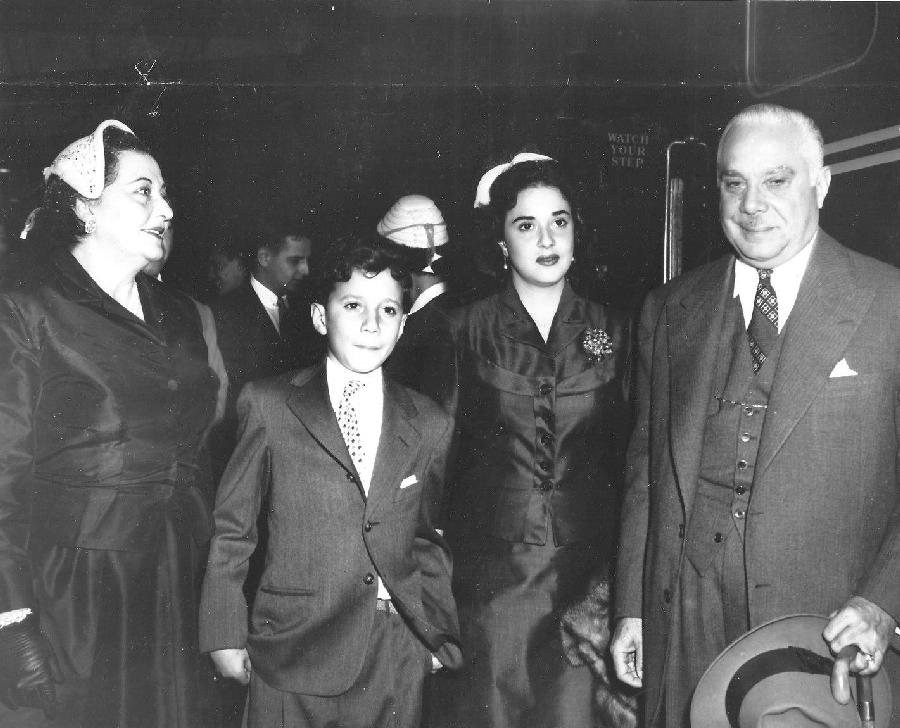
Dominican Republic History: Indepenence--Trujillo Dictatorship (1930-61)

Figure 1.--This photograph shows long-term Dominican Dictator Rafael Trujillo and his wife Maria with two of their children Radames and Angelia at the train station in New Orleans (October 1954). The press caption referred to him as the Generalisimo.
|
|
The U.S. Military Government (MG) formally ended (October 1922). Elections were held (1924). The winner
was former president Horacio Vásquez Lajara who had cooperated with the MG. He had briefly served as president (1902–03) before being deposed. He was inaugurated (July 13), and the last U.S. forces departed (September). Vásquez has one if the best records of all the Dominicn presidents with 6six years of honest, stable governance. Not only were political and civil rights observed and political violence subsided, but there was strong economic growth. The economy grew strongly, in a relatively peaceful atmosphere. As Presudent Vásquez Lajara was manuevering for another presiential term, Rafaél Leonides Trujillo Molina, a Lieutenant Colonel in the Dominican Army and Chief of Police. These positions gave hom the forece to seize power. He was also supporte by Carlos Rosario Peña, who headed the Civic Movement seeling to overthrow the government of Vásquez. Trujillo also cut a deal with rebel leader Rafael Estrella Ureña. Estrella would become a figurehead president and Trujillo
would run for president in new elections. As Estrella's rebels drove toward Santo Domingo, Vásquez ordered Trujillo to stop them. Trujill instead feigned neutrality and ordered his men to remain in thwir barracks. Estrella's rebel force occupied the capital with virtually no resistance. Estrella without any legal
justification was was proclaimed acting president with Trujillo confirmed as head of the police and the army (March 3). As agreed, Trujillo became the presidential nominee of the newly formed Coalición patriotica de los ciudadanos (Patriotic Coalition of Citizens) Estrella became his his running mate. The election was a fraud. Trujillo unleashed the Army and Police on a campihn of repression. Opposition igures were forced to withdraw. The result was preordained. He was elected elected president without any real oppostion (May) and was imagurated (August 16). He established another brutl dictatorship. Trujillo would go on to rule the country for three decades. He served as presidnt (1930-47 and then indirectly through urogates. He was perhaps the most corrupt Dominican rulers and certainly the most brutal. His rule was essentially gangster rule with murder and torture used to suppress any opposition to his authority. It is believd that thousands of Dominicans were murdered by his police thugs. After the Japanese attack on Pearl Harbor, the Dominican Republic Republic entered World War II, declaring war on Japan and Germany (Decemember 1941). There was substantial economic growth during the Trujillo's brutal regime. The Dominican people, however, unlike previous dictators did benefit, although because of the massive corruption not like should have. The wealth created went to the Trujillo family and his supporters. There was slome progress, most notably in healthcare, education, and transportation. Construction projects included hospitals and clinics, schools, roads, and harbors. Trujillo also instituted a housing construction program and a social security pension plan. He finally mangd to negotiated an undisputed border with Haiti (1935). He ended the 50-year customs agreement in 1941 rather than 1956 as had been planned. He paid off the naional debt (1947). As more Latin American countries moce toward demoracy, critism of Trujillo increased. First he used surogates, but the criticism mounted. The Organization of American States (OAS) called for its members to sever diplomatic ties with the Trujillp Administration. Trujillo was assasinated (1961). Elections followed.
Sources
CIH

Navigate the Children in Hitory Website:
[Return to the Main Dominican independence history page]
[Return to the Main Dominican history page]
[Return to the Main Dominican Republic page]
[Return to the Main Caribbean history page]
[Return to the Main Latin American page]
[About Us]
[Introduction]
[Biographies]
[Chronology]
[Climatology]
[Clothing]
[Disease and Health]
[Economics]
[Freedom]
[Geography]
[History]
[Human Nature]
[Law]
[Nationalism]
[Presidents]
[Religion]
[Royalty]
[Science]
[Social Class]
[Bibliographies]
[Contributions]
[FAQs]
[Glossaries]
[Images]
[Links]
[Registration]
[Tools]
[Children in History Home]
Created: 8:38 PM 12/21/2015
Last updated: 8:38 PM 12/21/2015



